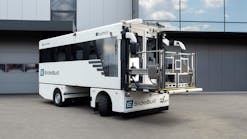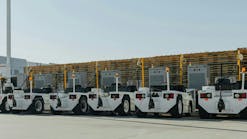How Airports Can Leverage Technology to Achieve Net Zero Carbon Emissions
Sustainability in aviation is a challenge in the skies and on the ground. For airports specifically, many of these challenges lie in the intense energy needs of terminals and equipment. Major airports run 24/7/365. Every component of its operations is constantly running to make sure travelers are safe and comfortable, airplanes arrive and depart on time, and vendors inside are able to run their businesses without issue.
The Federal Aviation Administration includes “the advancement of airport operations” as a priority in its Climate Action Plan to reach net zero emissions by 2050. To achieve this ambitious but achievable goal, the FAA’s recommended actions for airports include transitioning fleets to electric vehicles, improving energy efficiency and beginning sustainability planning and reporting. These are big costs for many airports to carry, necessitating the purchase of new equipment and potentially the growth or upskilling of their workforce.
Thankfully, there’s an abundance of climate-focused technology that can help airports easily manage their sustainability plans. By leveraging tech tools, airports can get on the right path to lowering their carbon emissions, reduce operational costs and provide more resources to employees to get closer to their long term goals.
Automated Energy Management Can Reduce Waste and Operational Costs
Net Zero can’t be accomplished easily or quickly if airports try to accomplish meaningful energy reductions through manual methods. With the intense amount of energy it takes to run these large, expansive facilities, a lot of employee hours are spent manually checking meters and equipment, gathering data. Then these employees spend hours poring over spreadsheets to establish baseline energy use or identify areas of improvement. This ultimately means that employees’ time and expertise are focused on routine data collection — but to move sustainability efforts forward employee resources need to be redirected toward project planning and execution.
By using technologies like sensors and applications that streamline data management and reporting, airports can have all their energy use monitored in real time. Climate tech can also leverage AI predictive modeling, helping airports forecast future energy fluctuations based on the number of passengers, changes in weather and more. This creates a number of perks for an airport’s facilities and energy management teams — namely, they can redirect their time and resources toward cost-saving, emissions-reducing energy efficiency projects when all the data they need is readily available to them. In addition, real-time data and updates can quickly catch abnormalities and alert employees to issues like damaged water pipes or broken equipment.
Reliable Carbon Emissions Reporting Can Help Guide the Path to Net Zero
Much like energy, airports need to understand their current carbon footprint in order to know where to focus their resources, plan future projects and measure their success year by year. But calculating emissions (otherwise known as carbon accounting) is a tricky task when done by hand. There’s a considerable margin for human error given the large scope of airport facilities, and because these numbers will drive stakeholders’ decision making and end up in public facing documents, it’s important this data is reliably accurate.
Technology tools can streamline the carbon accounting and reporting cycle for airports. Similar to energy use, carbon emissions can be automatically gathered from any and all sources like lighting, equipment, vehicles and more. This gives airports’ sustainability teams an easy, simplified way to identify the low-hanging fruit in their carbon footprint — the things that can easily be addressed at a low expense — and the long-term targets that require more planning and budgeting. With simplified access to emissions data at any point in the past and present, and even forecasts into the future, airports can more confidently report their progress and future outlook on the path to Net Zero.
Technology Can Expedite ROI and Carbon Reductions in Other Priority Areas
As airports can increase budgets for more extensive sustainability projects, the implementation of technology can help increase returns on these investments. For example, many airports are moving toward renewable energy sources like solar power, and supplementing installation with battery storage can improve efficiency and significantly reduce energy costs. San Diego International Airport, for example, recently reported it’s saved over $100,000 in demand costs by storing energy during peak demand times. These projects can even generate revenue, such as Dulles International Airport, which installed 300,000 solar panels that not only powers the airport itself but 37,000 nearby homes. Clean energy and storage options can both increase the cost effectiveness of electric vehicle fleets as well — reducing the cost of charging them through on-site generated power.
By prioritizing tech adoption in their sustainability journeys, airports can ease their pathway toward Net Zero, from the early to the later stages. By reducing time spent on manual processes, improving operational costs and finding innovative ways to complement and improve new projects, airports can make a significant difference in global sustainability and improve the global travel experience for decades to come.
Olivier Vidal serves as the senior director, enterprise sales at Acuity Brands, leading the sales globally for the entire Atrius portfolio across various verticals. With a career spanning over two decades, Vidal joined Acuity Brands in 2020 and has held a range of leadership roles in his career across account management, sales, product marketing, sales engineering in both travel and smart building industries.







